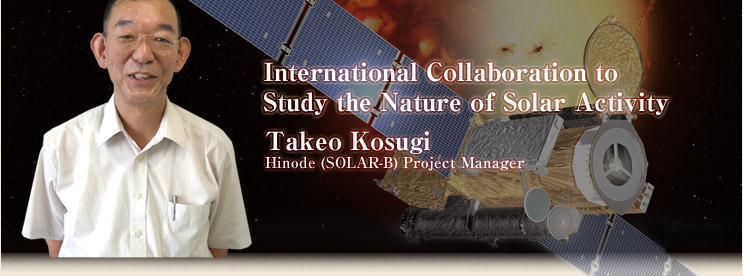
Hinode (SOLAR-B) is designed to observe the Sun, in order to investigate the heating mechanism of the Sun's corona and explosive phenomena taking place therein such as solar flares and coronal mass ejections (CMEs). Although coronae have been detected on other stars as well, the cause of their formation is still a great mystery to us. As well as unraveling the secrets of the solar corona and the mechanisms of explosive events in the corona, the Hinode satellite is set to make a great contribution to space weather forecasting - predicting the influence of solar activity on Earth.
The corona, which consists of plasma gas heated to 1 million to 3 million ºC, is the outermost, rarefied region of the solar atmosphere, about 2,000 km above the solar surface and extending into space. In the core of the Sun, nuclear fusion of gaseous hydrogen and helium atoms takes place, creating heat of about 15 million ºC. By the time this heat energy has reached the solar surface, it has greatly decreased, to about 6,000ºC, but, counter-intuitively, the corona is much hotter than the surface, at more than 1 million ºC. Why is this region, which is so far from the surface, hundreds of times hotter? This phenomenon has not yet been explained, but we believe coronal heating has a lot to do with magnetic field lines (i.e., the configuration of magnetic fields), since the corona is very hot and dense in areas of strong magnetic fields.
Hinode's top priority task is to precisely observe the solar magnetic fields not only in strength but also in direction, i.e., in vector, using the Solar Optical Telescope (SOT) by measuring polarized light emitted from specific atoms influenced by these magnetic fields. Such precise high-resolution measurements have never been done before, since measuring magnetic fields, especially their directions, are difficult to make, so this Observation would be a remarkable achievement.
The telescope also has the largest aperture - 50 cm - of all space-based optical telescopes used so far for solar Observations. Solar magnetic fields have been studied with satellite-mounted telescopes before, but previously such Observations have only measured the magnetic field component directed toward the telescope. Ground-based Observations of vector magnetic fields, on the other hand, lack precision because of the scintillation effect from the Earth's atmosphere. In brief, Hinode's telescope can achieve very high resolution, at about 0.2 to 0.3 arcseconds - 10 times higher than ground-based vector magnetic field Observation, which can manage only about 3.0 arcseconds.
Scientists believe that magnetic fields are formed in the convection zone of the Sun. When intense magnetic fields emerge on the solar surface, they are detected as sunspots. (A sunspot is a region with intense magnetic activity.) Using a technique called helioseismology, we can find the Sun's convection zone by closely observing solar oscillation with an optical solar telescope, a bit like studying the inner Earth by observing seismic waves. My goal is to study solar magnetic fields in depth, identifying the common characteristics of magnetic fields that emerge on the solar surface, and finding out how they trigger explosions and heating phenomena. I plan to do this through coronal Observations, imaging the inner convection zone, and tracking sunspot activity from energy storage to release. I am certain this will help us reveal the dynamics of the corona - why it's so extremely hot, at over one million degrees.
Conditions outside the Earth's atmosphere are called space weather, and within our solar system these conditions are greatly influenced by solar activity. Solar wind - plasma that's been ejected from the Sun's corona - gets pushed towards the Earth by solar explosions like a giant tsunami, and causes geomagnetic storms when it strikes the Earth. The storms produce high-energy particles and a strong electrical surge, which can severely interfere with daily life, disrupting radio communications and damaging satellites. High-energy particles are also emitted from solar-flare explosions, creating a serious problem for astronauts in space. In the case of manned exploration of Mars for instance, it will take almost a year just to get there, so astronauts' exposure to high-energy particles (i.e. radiation) will be a big concern. By observing solar activities, however, we can predict when such an intense stream of high-energy particles and/or a tsunami in solar wind from the Sun will strike the Earth. This is called space-weather forecasting.
By the time we are able to detect a giant solar explosion, there are only about 10 minutes left until high-energy particles bombard the Earth. The solar-wind shock wave, which causes a geomagnetic storm, follows two days later. Two days may be enough time to minimize the potential damage, but 10 minutes certainly isn't. So it is very important to be able to read the symptoms and predict an explosion in advance, rather than raising the alert after the event has occurred. I would like to use the Hinode satellite to uncover the dynamics of solar eruptive phenomena, and improve space-weather forecasting.
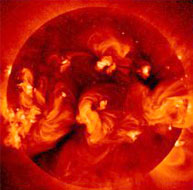
Solar corona in soft X-rays (imaged by Yohkoh)
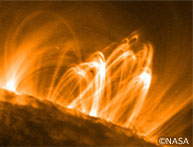
Solar corona in ultraviolet light (imaged by TRACE)
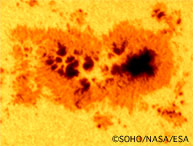
Sunspots
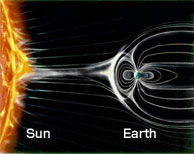
Solar wind and the Earth's magnetosphere